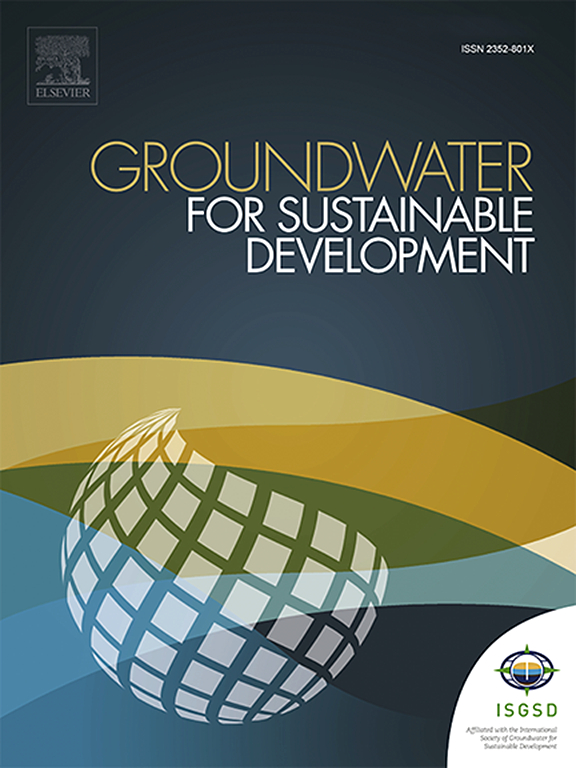Hydrogeochemical processes in different sources of the hydrocarbon contaminated karst groundwater with emphasizing on iodine species, south west Iran
IF 4.9
Q2 ENGINEERING, ENVIRONMENTAL
引用次数: 0
Abstract
Karst aquifers, the significant drinking water sources, are prone to contamination from natural and anthropogenic pollutants due to their unique hydrogeological conditions. This study determines the impact of hydrocarbon contamination on the source of iodine, fluoride, and TOC in groundwater in the Southwest provinces of Iran. A total of 30 water samples—including shallow karst groundwater (n = 13) and deep oilfield brine (n = 3)—were collected during two seasons (August 2021 and February 2022). In this regard, the concentrations of iodine isotopes (129I and 127I, 129I/127I ratio), halogens (I, F, Br, Cl), TOC, and BTEX compounds (benzene, toluene, ethylbenzene, xylene) were analyzed to trace contamination sources and processes. The major chemical composition of the samples consist of CaSO4, CaHCO3, and NaCl types. The concentrations of iodine and fluoride in groundwater ranged from 1.93 to 435 mg/L and 0.11–1.5 mg/L, respectively, with the highest values observed in samples affected by bitumen seepage (S6) and oil contamination (P2). The 129I/127I vs. 1/127I, 129I vs. Cl, and 127I vs. Cl graphs show a clear distinction between different karst groundwater samples and related pollution revealed distinct contamination patterns among groundwater sources, highlighting mixing between different recharge sources and the pronounced contamination of modern iodine compared to modern rain. Our findings offer new perspectives on the proportions of iodine isotopes ratio (129I/127I) and the concentrations of I and F. These insights highlight that water mixing, dilution, and hydrocarbon pollution are the primary elements influencing karst aquifers in the researched region.

伊朗西南部岩溶地下水不同来源烃类污染的水文地球化学过程,重点是碘类
喀斯特含水层是我国重要的饮用水源,由于其独特的水文地质条件,容易受到自然和人为污染物的污染。本研究确定了碳氢化合物污染对伊朗西南省份地下水中碘、氟和TOC来源的影响。在两个季节(2021年8月和2022年2月)共收集了30个水样,包括浅层岩溶地下水(n = 13)和深层油田盐水(n = 3)。为此,分析了碘同位素(129I和127I、129I/127I比值)、卤素(I、F、Br、Cl)、TOC和BTEX化合物(苯、甲苯、乙苯、二甲苯)的浓度,以追踪污染源和污染过程。样品的主要化学成分为CaSO4、CaHCO3和NaCl。地下水中碘和氟的浓度分别为1.93 ~ 435 mg/L和0.11 ~ 1.5 mg/L,受沥青渗漏(S6)和石油污染(P2)影响的样品中碘和氟的浓度最高。129I/127I vs. 1/127I、129I vs. Cl和127I vs. Cl图显示了不同岩溶地下水样本之间的明显区别,相关污染揭示了地下水来源之间不同的污染模式,突出了不同补给源之间的混合,与现代降雨相比,现代碘的污染明显。研究结果为研究区岩溶含水层的碘同位素比值(129I/127I)和碘、氟的浓度提供了新的视角,强调了水的混合、稀释和烃污染是影响研究区岩溶含水层的主要因素。
本文章由计算机程序翻译,如有差异,请以英文原文为准。
求助全文
约1分钟内获得全文
求助全文
来源期刊

Groundwater for Sustainable Development
Social Sciences-Geography, Planning and Development
CiteScore
11.50
自引率
10.20%
发文量
152
期刊介绍:
Groundwater for Sustainable Development is directed to different stakeholders and professionals, including government and non-governmental organizations, international funding agencies, universities, public water institutions, public health and other public/private sector professionals, and other relevant institutions. It is aimed at professionals, academics and students in the fields of disciplines such as: groundwater and its connection to surface hydrology and environment, soil sciences, engineering, ecology, microbiology, atmospheric sciences, analytical chemistry, hydro-engineering, water technology, environmental ethics, economics, public health, policy, as well as social sciences, legal disciplines, or any other area connected with water issues. The objectives of this journal are to facilitate: • The improvement of effective and sustainable management of water resources across the globe. • The improvement of human access to groundwater resources in adequate quantity and good quality. • The meeting of the increasing demand for drinking and irrigation water needed for food security to contribute to a social and economically sound human development. • The creation of a global inter- and multidisciplinary platform and forum to improve our understanding of groundwater resources and to advocate their effective and sustainable management and protection against contamination. • Interdisciplinary information exchange and to stimulate scientific research in the fields of groundwater related sciences and social and health sciences required to achieve the United Nations Millennium Development Goals for sustainable development.
 求助内容:
求助内容: 应助结果提醒方式:
应助结果提醒方式:


